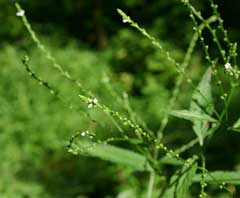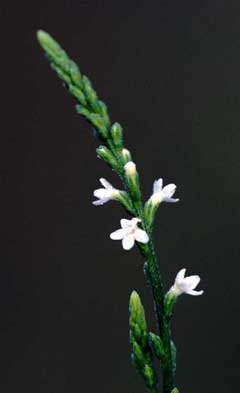 |
|
commons.wikimedia.org/wiki/User:SB_Johnny |
 |
| Thomas G. Barnes @ USDA-NRCS PLANTS Database / Barnes, T.G., and S.W. Francis. 2004. Wildflowers and ferns of Kentucky. University Press of Kentucky. |
Translate this page:
Summary
Physical Characteristics

 Verbena urticifolia is a PERENNIAL growing to 0.3 m (1ft).
Verbena urticifolia is a PERENNIAL growing to 0.3 m (1ft).
See above for USDA hardiness. It is hardy to UK zone 5. The species is hermaphrodite (has both male and female organs) and is pollinated by Bees, flies, Lepidoptera (Moths & Butterflies). The plant is self-fertile.
Suitable for: light (sandy), medium (loamy) and heavy (clay) soils and prefers well-drained soil. Suitable pH: mildly acid, neutral and basic (mildly alkaline) soils. It cannot grow in the shade. It prefers moist soil.
UK Hardiness Map
US Hardiness Map
Synonyms
Plant Habitats
Woodland Garden Sunny Edge; Cultivated Beds;
Edible Uses
References More on Edible Uses
Medicinal Uses
Plants For A Future can not take any responsibility for any adverse effects from the use of plants. Always seek advice from a professional before using a plant medicinally.
Miscellany Restorative Women's complaints
A decoction of the root is given to babies to break out the hives[207]. The sweetened root decoction is drunk as an aid for flu[207]. An infusion of the root has been used in the treatment of profuse menstruation[257]. The root has been eaten to revive a patient and restore them to health[257].
References More on Medicinal Uses
The Bookshop: Edible Plant Books
Our Latest books on Perennial Plants For Food Forests and Permaculture Gardens in paperback or digital formats.

Edible Tropical Plants
Food Forest Plants for Hotter Conditions: 250+ Plants For Tropical Food Forests & Permaculture Gardens.
More

Edible Temperate Plants
Plants for Your Food Forest: 500 Plants for Temperate Food Forests & Permaculture Gardens.
More

More Books
PFAF have eight books available in paperback and digital formats. Browse the shop for more information.
Shop Now
Other Uses
References More on Other Uses
Cultivation details
Succeeds in any moderately fertile well-drained but moisture retentive soil in a sunny position[1, 200]. Hardy to about -15°c[200].
References Carbon Farming Information and Carbon Sequestration Information
Temperature Converter
Type a value in the Celsius field to convert the value to Fahrenheit:
Fahrenheit:
The PFAF Bookshop
Plants For A Future have a number of books available in paperback and digital form. Book titles include Edible Plants, Edible Perennials, Edible Trees,Edible Shrubs, Woodland Gardening, and Temperate Food Forest Plants. Our new book is Food Forest Plants For Hotter Conditions (Tropical and Sub-Tropical).
Shop Now
Plant Propagation
Seed - sow early spring in a greenhouse or cold frame[1]. When they are large enough to handle, prick the seedlings out into individual pots and plant them out in the summer. Division in spring. Larger divisions can be planted out direct into their permanent positions. We have found that it is best to pot up smaller divisions and grow them on in light shade in a greenhouse or cold frame until they are growing away well. Plant them out in the summer or the following spring. Basal cuttings in early summer. Harvest the shoots with plenty of underground stem when they are about 8 - 10cm above the ground. Pot them up into individual pots and keep them in light shade in a cold frame or greenhouse until they are rooting well. Plant them out in the summer.
Other Names
If available other names are mentioned here
Native Range
NORTHERN AMERICA: Canada (Québec (south), Ontario (south), New Brunswick, Saskatchewan (southeast)), United States (Indiana, Maine, Massachusetts, Michigan, New Hampshire, New Jersey, New York, Ohio, Pennsylvania, Rhode Island, Vermont, West Virginia, Connecticut, Iowa, Kansas, Minnesota, Missouri, Nebraska, South Dakota, Oklahoma, Wisconsin, Alabama, Arkansas, Delaware, District of Columbia, Florida (north), Georgia, Kentucky, Louisiana, Maryland, North Carolina, South Carolina, Virginia, Mississippi, Tennessee, Texas)
Weed Potential
Right plant wrong place. We are currently updating this section.
Please note that a plant may be invasive in one area but may not in your area so it's worth checking.
Conservation Status
IUCN Red List of Threatened Plants Status :

| Related Plants
|
| Latin Name | Common Name | Habit | Height | Hardiness | Growth | Soil | Shade | Moisture | Edible | Medicinal | Other |
| Abronia fragrans | Snowball Sand Verbena | Perennial | 0.6 |
7-10
| | LM | N | DM | 2 | 1 | 0 |
| Abronia latifolia | Sand Verbena, Coastal sand verbena | Perennial | 0.1 |
7-10
| | L | N | DM | 2 | 0 | |
| Abronia turbinata | Transmontane Sand Verbena | Perennial | 0.1 |
-
| | L | N | DM | 0 | 1 | |
| Abronia villosa | Desert Sand Verbena | Annual | 0.1 |
7-10
| | L | N | DM | 0 | 1 | |
| Aloysia citriodora | Lemon Verbena, Lemon beebrush | Shrub | 3.0 |
7-10
| M | LM | SN | DM | 4 | 3 | 3 |
| Aloysia gratissima | Whitebrush | Shrub | 3.0 |
7-9
| F | LM | N | DM | 2 | 2 | 2 |
| Aloysia wrightii | Oreganillo, Sonoran Beebrush | Shrub | 3.0 |
8-10
| M | LM | N | DM | 1 | 0 | 2 |
| Callicarpa americana | American Beautyberry, Beautyberry, French Mulberry, American Beautyberry | Shrub | 1.8 |
7-10
| S | M | SN | M | 2 | 2 | |
| Callicarpa japonica | Beautyberry, Japanese callicarpa, Japanese Beautyberry | Shrub | 2.0 |
5-8
| M | LMH | SN | M | 1 | 0 | |
| Callicarpa macrophylla | | Shrub | 2.5 |
8-11
| | LMH | SN | M | 1 | 2 | 2 |
| Callicarpa mollis | | Shrub | 2.4 |
7-10
| | M | N | M | 1 | 0 | |
| Callicarpa pedunculata | | Shrub | 3.0 |
9-11
| | LMH | N | M | 0 | 2 | |
| Clerodendrum bungei | Glory Flower, Rose glorybower, Cashmere Bouquet, Mexican Hydrangea, Glory Bower | Shrub | 2.0 |
7-9
| M | LMH | N | M | 0 | 1 | 0 |
| Clerodendrum cyrtophyllum | | Shrub | 3.0 |
-
| | LMH | N | M | 1 | 1 | |
| Clerodendrum japonicum | Japanese glorybower | Shrub | 2.5 |
9-11
| | LMH | N | M | 1 | 1 | |
| Clerodendrum kwangtungense | | Shrub | 3.0 |
-
| | LMH | N | M | 1 | 0 | |
| Clerodendrum trichotomum | Chou Wu Tong, Harlequin glorybower, Ferruginous clerodendrum, Harlequin Glory Bower | Tree | 6.0 |
6-11
| M | LMH | N | M | 1 | 3 | |
| Glandularia canadensis | Rose Verbena | Perennial | 0.3 |
5-9
| M | LMH | SN | DM | 0 | 0 | 3 |
| Lantana camara | Wild Sage, Lantana Verbena | Shrub | 1.8 |
8-12
| F | LMH | SN | DMWe | 2 | 4 | 3 |
| Lippia graveolens | Mexican Oregano | Shrub | 2.0 |
9-12
| F | LMH | N | DM | 4 | 0 | 1 |
| Phyla nodiflora | Frogfruit, Turkey tangle fogfruit | Perennial | 0.2 |
8-12
| | LMH | N | DM | 1 | 2 | 3 |
| Salvia verbenaca | Wild Clary | Perennial | 0.6 |
5-9
| | LM | N | DM | 2 | 2 | |
| Verbena hastata | American Blue Vervain, Swamp verbena | Perennial | 1.5 |
3-7
| | LMH | N | M | 1 | 2 | 0 |
| Verbena officinalis | Vervain, Herb of the cross, Prostrate verbena | Perennial | 0.6 |
4-8
| | LMH | N | M | 1 | 3 | |
| Verbena stricta | Hoary Vervain, Hoary verbena | Perennial | 1.0 |
4-8
| | LMH | N | M | 1 | 1 | 0 |
| Vitex agnus-castus | Agnus Castus, Lilac chastetree, Vitex, Chastetree | Shrub | 3.0 |
7-9
| M | LM | N | DM | 2 | 5 | 3 |
| Vitex cannabifolia | | Shrub | 3.0 |
-
| | LM | N | DM | 0 | 2 | 1 |
| Vitex negundo | Huang Ping, Chinese chastetree, Cut Leaf Vitex, Cut-leaf Chastetree | Shrub | 3.0 |
6-9
| M | LM | N | DM | 2 | 3 | 2 |
|
Growth: S = slow M = medium F = fast. Soil: L = light (sandy) M = medium H = heavy (clay). pH: A = acid N = neutral B = basic (alkaline). Shade: F = full shade S = semi-shade N = no shade. Moisture: D = dry M = Moist We = wet Wa = water.
Now available:
Food Forest Plants for Mediterranean Conditions
350+ Perennial Plants For Mediterranean and Drier Food Forests and Permaculture Gardens.
[Paperback and eBook]
This is the third in Plants For A Future's series of plant guides for food forests tailored to
specific climate zones. Following volumes on temperate and tropical ecosystems, this book focuses
on species suited to Mediterranean conditions—regions with hot, dry summers and cool, wet winters,
often facing the added challenge of climate change.
Read More
Expert comment
Author
L.
Botanical References
43200
Links / References
For a list of references used on this page please go here
Readers comment
© 2010, Plants For A Future. Plants For A Future is a charitable company limited by guarantee, registered in England and Wales. Charity No. 1057719, Company No. 3204567.